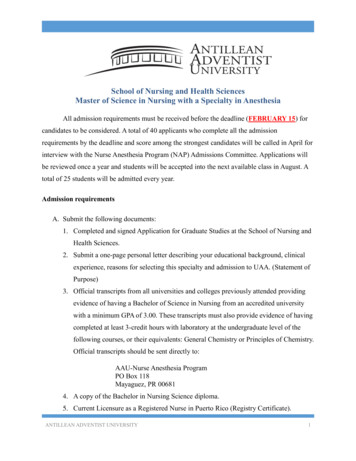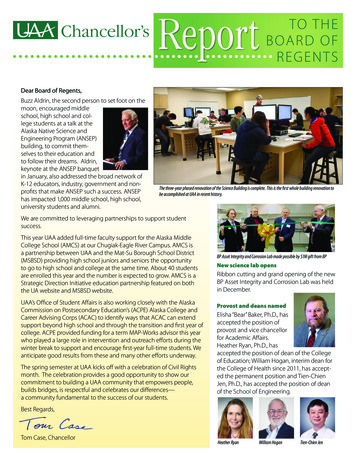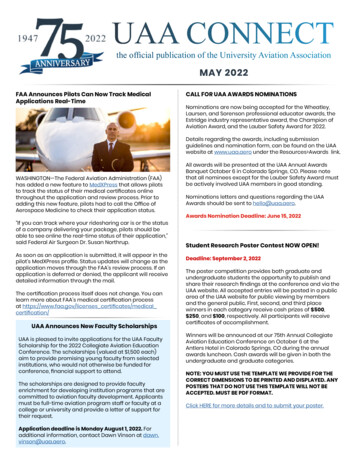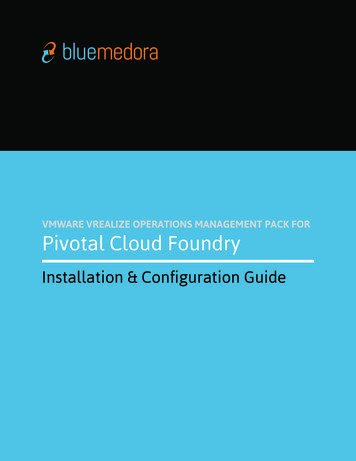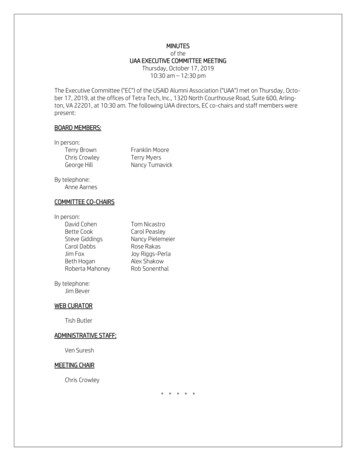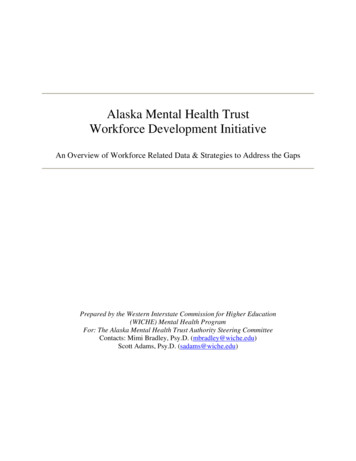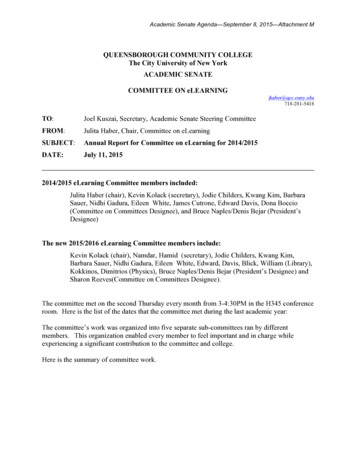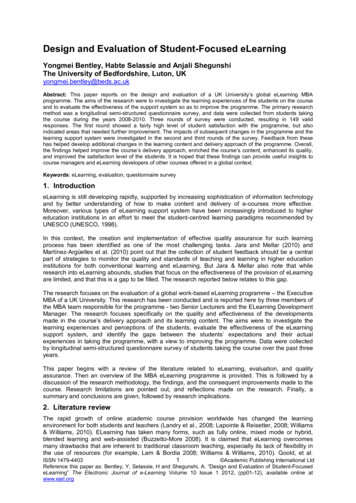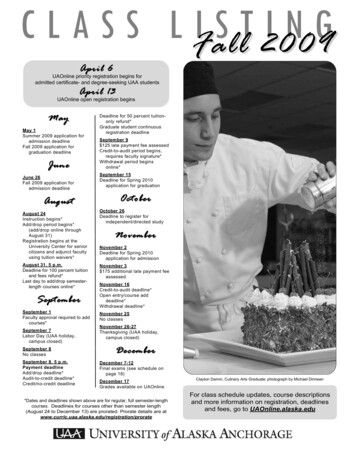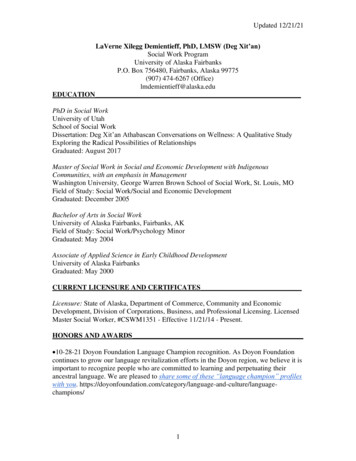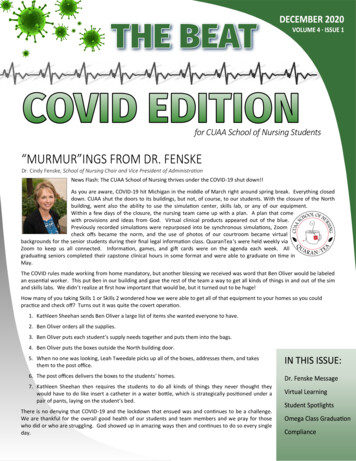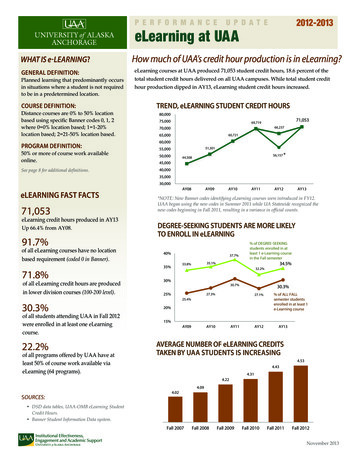
Transcription
P E R F O R M A N C E2012-2013U P DAT EeLearning at UAAWHAT IS e-lEARNING?General Definition:Planned learning that predominantly occursin situations where a student is not requiredto be in a predetermined location.Course Definition:Distance courses are 0% to 50% locationbased using specific Banner codes 0, 1, 2where 0 0% location based; 1 1-20%location based; 2 21-50% location based.Program Definition:50% or more of course work availableonline.See page 8 for additional definitions.How much of UAA’s credit hour production is in eLearning?eLearning courses at UAA produced 71,053 student credit hours, 18.6 percent of thetotal student credit hours delivered on all UAA campuses. While total student credithour production dipped in AY13, eLearning student credit hours increased.Trend, eLEARNING STUDENT CREDIT 72160,00051,30155,00050,00056,157 *44,50845,00040,00035,00030,000eLEARNING fAST FACTS71,053eLearning credit hours produced in AY13Up 66.4% from AY08.91.7%of all eLearning courses have no locationbased requirement (coded 0 in Banner).71.8%of all eLearning credit hours are producedin lower division courses (100-200 level).30.3%of all students attending UAA in Fall 2012were enrolled in at least one eLearningcourse.22.2%of all programs offered by UAA have atleast 50% of course work available viaeLearning (64 programs).AY08AY09AY10AY11AY12AY13*NOTE: New Banner codes identifying eLearning courses were introduced in FY12.UAA began using the new codes in Summer 2011 while UA Statewide recognized thenew codes beginning in Fall 2011, resulting in a variance in official counts.DEGREE-SEEKING STUDENTS ARE MORE LIKELYTO ENROLL IN eLEARNING40%37.7%34.5%35.1%33.8%35%% of DEGREE-SEEKINGstudents enrolled in atleast 1 e-Learning coursein the Fall semester32.2%30%30.7%25%30.3%27.3%27.1%25.4%20%% of ALL FALLsemester studentsenrolled in at least 1e-Learning course15%AY09AY10AY11AY12AY13AVERAGE NUMBER OF eLEARNING CREDITSTAKEN BY uaa STUDENTS IS INCREASING4.534.434.314.224.09SOURCES:4.02 DSD data tables, UAA-OMB eLearning StudentCredit Hours. Banner Student Information Data system.Fall 2007Fall 2008Fall 2009Fall 2010Fall 2011Fall 2012November 2013
eLearning at UAA2012-2013Who are the biggest eLearning credit hour producers?eLEARNING AS % OF TOTALCREDIT HOURS IN AY13Kenai Peninsula College produced 18,221 credit hours via eLearning in 2013, just over26 percent of all eLearning credit hours. The second largest producer is the College ofArts & Sciences at 16,758 credit hours.By CampusKenai54.6%Kodiak54.2%Prince WilliamSoundEducation7%Engineering2%Community &Technical13%34.4%AnchorageMat-SueLearning Credit Hour u4%Business9%By Course levelPrince WilliamSound4%Arts & Sciences23%Lower Division72%Upper Division16%eLearning Credit Hour Growth by e2,263473Kenai4,5553,094 2,8111,545 1,893 2,601KodiakMat-Su120Prince William SoundeLEARNING STUDENT CREDIT HOURS BY COURSE LEVEL20082009eLearningPage %10%0%2013Face-to-FaceNovember 2013
eLearning at UAA2012-2013How many degree programs are available via eLearning?The number of programs available at least 50 percent via eLearning increased from 51in 2012 to 64 in 2013, a 25 percent increase. This compares to a 2 percent increase in thenumber of all programs offered by UAA from 2012 to 2013.22 PERCENT OF PROGRAMS ARE AVAILABLE VIA eLEARNING100%available viaeLearning12% (34)1-50%available viaeLearning10% (30)20 DISCIPLINES PRODUCED 75% OF ALL eLEARNINGCREDIT HOURS IN 2013English8,082Psychology5,068Business Administration4,4764,017Mathematics2,871Dietetics & Nutrition2,686Economics2,127Biology1,990Computer Office Systems1,931Accounting1,680Communication1,656Five subjects produce 35 percent ofSpecial Education1,650eLearning student credit hours:Chemistry1,425Political Science1,347Process Tech1,321ArtHealth SciencesHuman Services1,2221,1351,017Education Dvlp & vember 2013 Arctic Engineering, MSBookkeeping Support, OECCareer & Technical Education, GCRT, MSChildren’s Behavioral Health, OECCivil Drafting, CT1Computer Information Office Systems,AAS, CT2, OECCorrections, CT1, OECDigital Art, AASDisability Services Specialist, AAS, CT2,OECDirect Services Specialist, OECEarly Childhood Special Education, MEDEducational Leadership, MEDGeneral Program, AAHuman Services, AASIndustrial Technology, AAS, CT2Medical Office Coding, OECNursing Education, GCRTNursing Science, BSOffice Digital Media, OECOffice Foundations, OECOffice Support, OECOccupational Safety & Health, AASPharmacy Technology, OECPublic Health Practice, MPHSpecial Education, GCRT, MEDSuperintendent, GCRTDEGREE PROGRAMS AVAILABLE1-50% VIA eLEARNING3,732Philosophy All others78%HistoryDEGREE PROGRAMS AVAILABLE100% VIA eLEARNING English Psychology Business Administration History Mathematics Accounting, AASClinical Assistant, OECCounselor Education, MEDCreative Writing, MFADietetics, BSEarly Childhood Development, AAS, CT1Early Childhood Education, BA, PBCTEducation, MATElementary Ed (K-6), PBCTElementary Education, BAGeneral Business, AASGeneral Program, AAIndustrial Safety Program Specialist, CT1Language Education, GCRTLimited Radiography, OECNursing Science, MSNutrition, BSOutdoor Leadership, AASPetroleum Technology, CT1Phlebotomist, OECPlaywriting, AFAPrincipal, GCRTProcess Technology, AASProject Management, MSSocial Work, MSWTeaching and Learning, MEDTechnology, BSPage 3
eLearning at UAAExternal resourcesThe Faculty Technology Center (FTC) provides instructors accessto additional resources outside of UAA bypurchasing institutional membership inthe following programs specializing in electronic learning:The Sloan Consortium is an institutional and professional leadership organization dedicated to integrating onlineeducation intothe mainstreamof higher education, and helpinginstitutions andindividual educators improve the quality,scale, and breadth of education. Last year,the FTC paid for ten instructors to beginthe Sloan-C Online Teaching Certificateprogram. http://sloanconsortium.org/The Association forAuthentic, Experiential andEvidence-Based Learning(AAEEBL) is the leadingnational organizationdevoted to use of electronic portfolios tosupport learning. UAA’s membershipallows instructors and staff access toAAEEBL’s resources, newsletters, anddiscounted rates for attending conferences.http://www.aaeebl.org/The EDUCAUSE LearningInitiative (ELI) is a communityof higher education institutionsand organizations committed tothe advancement of learning through “theinnovative application of technology.”Membership allows instructors access toresearch, resources, and discounted ratesfor conferences. http://www.educause.edu/Atomic Learningprovides onlinetraining resourcesfor over 250 software tools which are available to all UAA faculty, staff and studentsto improve their use and knowledge ofboth software and hardware. http://www.atomiclearning.com/Page 42012-2013How is UAA supporting faculty in developing onlinecourses and programs?The University of Alaska Anchorage provides a broad range of online offerings, as wellas face-to-face campus specific professional development opportunities, for facultyinterested in developing or offering online courses and programs.uaa Faculty Technology CenterThe UAA Faculty Technology Center (FTC), located on the Anchorage campus, provides UAA instructors with both technologically-focused professional developmentopportunities and instructional design services. The FTC is currently staffed withfive instructional designers and one media technician to serve the needs of approximately 1,500 instructors across our campuses, and offers both professional development workshops and consultation services for individual instructors and programs ordepartments. The FTC also oversees UAA’s Technology Fellowship program, offeringinstructors and staff a multi-year intensive focus on the use of technology within education.Professional Development WorkshopsDuring the 2012-2013 academic year, the FTC hosted 92 workshops attended by 494instructors. A sample of topics is listed below. Introduction to BlackboardMultiple Blackboard workshops focused on various function areasSynchronous communication with eLive or CollaborateMoving your course onlineWorking with videoBeing your own IT supportInstructional design principlesGoogle Apps for EducationApple tools such as iTunesU and iBooks AuthoriTeach UAAIn collaboration with UAF’s eLearning and Distance Education, the FTC brought theiTeach intensive to UAA. This 5-day intensive hands-on clinic was offered to UAAinstructors interested in improving their online course delivery skills. Nine faculty andone staff member participated in the first UAA iTeach session in May 2013.UAA Technology FellowshipThe UAA Technology Fellowship is designed to build skills and abilities related tointegrating technology to support teaching and learning. Fellows mentor colleaguesinterested in integrating technology into instruction. The program has run annuallysince 2005. This year nine instructors and one staff person selected from 27 applicantsfocused on building an online course.Sloan-C Teaching Online Certificate ProgramThe UA System provided funding that allowed 11 faculty members from three campuses and eight disciplines to participate in the summer 9-week certificate program. Thisnationally recognized certificate program, providing a foundational course and threeone-week long electives in which faculty can learn to better master online teaching.November 2013
2012-2013Kenai Peninsula College (KPC)Supported by the College and a Title III grant, tenured, tenure-track,term and adjunct faculty teaching online courses can attend an eLearning/Technology week-long workshop held every May, or receiveone-on-one instruction from a KPC instructional designer.elearning Training Provided to Faculty KPC Excellence in eLearning workshop - May & August (weeklong workshop)Applying the Quality Matters Rubric - online trainingQM Peer Reviewer online trainings and QM Peer Reviewer CertificationVarious Quality Matters online trainings including: Building Your Online Course Addressing Accessibility Adjunct Orientation to Blackboard Camtasia, Voicethread, and iPad workshops Strengths-based Training for Leadership, Mentoring and Advising Mobile LearningeLearning at UAAKenai Peninsula CollegeOnline modules for developmental mathdeveloped by Kenai Peninsula Collegefaculty are now part ofCarnegie MellonUniversity’s OpenLearning Initiative (OLI).They form the first remedial-developmental courses on OLI. The modules weredeveloped to support the Trade Adjustment Assistance Community and CareerTraining (TAACCT) grant awarded toUAA’s Community and Technical Collegeand Kenai Peninsula College in Fall 2011.Consultation and training for developing and teaching online courses is offered atvarious times, and includes Blackboard, eLive/Collaborate, teaching tools, instructionaldesign, time management, and online teaching techniques.Kenai Peninsula College recently completed a 1.99 million Title III grant for increasingstudent success/retention rates through technology-enhanced advising and tutoringservices, development of distance delivered courses in technical fields and generaleducation requirements, and faculty development and training in classroom technologyand distance education.Sixteen sessions focused on instructionand technology are available for allfaculty this month. For details /etech-fair.cfmKodiak CollegeProfessional development is offered to faculty in person, via web,or recorded digital files on the College’s website for easy access forinstructors teaching from a distance. Offerings include Fall & SpringAll-Faculty Professional Development Seminars, meetings and orientations for newtechnology tools/changes, VoiceThread, Atomic Learning, Blackboard, and BlackboardCollaborate.Help sessions offered to faculty: Email/WolflinkUAOlineGoogle AppsSmartPenApp-a-palooza: all things “apps” related for iPads, iPods, iDevices, SmartPhonesUnderstanding by DesignStudentLingo On-Demand Student Success WorkshopsKodiak provides access to free StudentLingo workshops for the entire state at http://www.koc.alaska.edu/student-lingo-survey. Workshop categories include:: 10 Tips for Success in Your Online CourseEffectively Communicating OnlineHow to Stay Motivated & Disciplined OnlineTaking Tests Online: Tips for SuccessKodiak CollegeKodiak College was awarded a TradeAdjustment Assistance Community andCareer Training (TAACCT) grant to workwith online labs in health care classes.Kodiak College also received a Title IIIGrant from the Department ofEducation to fund Kodiak College’s SeaChange: Growing Enrollment with RealWorld, Real-Time Student-CenteredDistance Education.This program is developing island/coastalthemed distance education incorporatingglobal topics and direct interaction withfaculty and Kodiak Island through cuttingedge learning resources and technologyinfrastructure. It is supported by academicand student support services.Page 5
eLearning at UAA2012-2013What Is UAA doing to ensure eLearning course quality?eTextbooksUAA participated in a national pilot studyof eTextbooks. The overall goal was to evaluate the effectiveness of eTexts in highereducation and to test new models of textbook delivery and mass deployment. UAAwas among 25Ensuring course quality is always a priority. For the past few years theAnchorage campus has ensured quality standards by using a course design checklistdeveloped by instructional designers, faculty and staff across UAA. The checklistprovides a rubric of multiple categories including the syllabus, course content,interaction and collaboration activities, assessment plan, and student support. Aworkgroup is examining this more closely and will propose a program/process thatUAA can adopt to meet both our internal design standards and nationally establishedcolleges anddistance education benchmarks.universitiesproviding eTextsTwo community campuses, Kenai Peninsula College and Kodiak College, have adoptedto their studentsthe Quality Matters (QM) framework to ensure quality in distance education. QM is aas part of theleader in quality assurance for online education and has received national recognitionpilot.for its peer-based approach to continuousSixteen sections of courses were selected atUAA Anchorage and Kenai PeninsulaCollege campuses, encompassing 320students. Data was collected from studentsand instructors, and other considerationswere researched including pricing, effectiveness, student engagement and nationaltrends.improvement in online education andstudent learning.At Kodiak College, 42 individuals havebeen trained, two courses have receivedcertification, and more are in the queue to bereviewed. At Kenai Peninsula College 140individuals have been trained, eight courseshave been QM-certified and 10 courses arein the midst of the review process.The pilot usedCourseloadeReader software, whichintegrated intoUAA’s Blackboard system and was available on somemobile devices. The eTexts were interactiveand could be annotated by the instructorsand the students. The eTexts (McGraw HilliDESIGN STATEWIDE MEETINGRe-establishing communication with similar programs at both UAF and UAS, UAA’sFaculty Technology Center helped to organize a statewide iDesign meeting. Held inJune 2013, iDesign was the first meeting of UA instructional designers statewide in overseven years. Over two days, participants from all three universities worked togetherto find ways to establish regular communication, collaborate on projects, and shareresources. This effort will lead to more consistent opportunities, resources and materialsfor all UA faculty and staff regardless of their location.texts) were free to students, an estimatedvalue of 43,170 worth of free course textsduring the Fall 2012 eText pilot.BLACKBOARD CERTIFIED TRAINERSUAA trained three new instructional designers to become Blackboard CertifiedUAA’s findings were included in a nationalTrainers. Spread across the university, these three individuals are now able to providecross-institutional study and a final reportbetter support and service to both faculty and students when issues or upgrades withwas released by Educause and Internet2 inBlackboard arise.June 2013.Page 6November 2013
2012-2013Who is taking and who is teaching eLearning courses?Just under a third of all students enrolled at UAA took at least one eLearning coursein the Fall of 2012. That is up from 25 percent five years ago. Students enrolled in ateLearning at UAASTUDENT PROFILESCOMPARING eLEARNING TOFACE-TO-FACE ONLYleast one eLearning course are more likely to be degree-seeking and older.The majority of eLearning instructors are regular/term faculty (60%) across allcampuses. However, Kenai Peninsula College had the highest percentage of adjuncts(55%) teaching eLearning courses in Fall 2012 while at Kodiak College only 25% weretaught by adjuncts.Enrolled inat least 1eLearningcourseEnrolled inFace-to-Facecourses only30%70%60% OF eLEARNING SECTIONS ARE TAUGHTBY REGULAR/TERM FACULTYFACE-TOFACEONLYAT LEAST 1eLEARNINGCOURSEAll Students70%30%% Degree-Seeking69%84%% Full-time40%43%% Part-time60%57%% First-timeFreshmen13%6%% UpperClassmen38%57%% Age 17-1926%11%% Age 20-3957%74%% Age 40 & Over16%16%% Minority27%25%% from Alaska91%90%% Out-of-State6%8%% International2%2%Tenured22%Adjunct40%On TenureTrack12%Term Faculty26%THE HIGHEST PASS RATES FOR eLEARNING STUDENTS AREIN UPPER, PROFESSIONAL & GRADUATE LEVEL COURSESeLearningFace-to-Face(0 location TE: The percentages above are based on thetotals for each population in Fall 2012. For example,of the 13,826 students enrolled in only Face-to-Facecourses in Fall 2012, 69% (9,585) were degreeseeking while of the 5,999 students enrolled inat least one eLearning course, 84% (5,046) weredegree-seeking.55.5%56.5%NOTE: Passing Grades A, B, C, P for Undergraduate level courses and A, B, P for Graduate level. TheeLearning pass rate measured here is for courses coded “0” (0 location based).November 2013Page 7
P E R F O R M A N C E2012-2013U P DAT EeLearning at UAAWhat’s new for 2014-15?ePORTFOLIOS:UAA’s Faculty Technology Center is hiring an ePortfolio Coordinator who will begin work at the start of theSpring 2014 semester. This fulfills a UAA Faculty Senate initiative supporting the use of ePortfolios for enhancing, assessing, andshowcasing student learning as an option for those faculty and programs that choose to use them.EdgeUPass (or Passport) Program:Credentials for Professional DevelopmentThe Faculty Technology Center’s Passport Program is exploring models for digital badge credentialsfor professional development that may be coupled with additional incentives, such as promotion/tenure, institutional recognition, faculty mentor opportunities and national professional developmentprograms. The digital badge credential provides metadata linking back to the evidence of learningthat happens in and beyond the classroom. Badges give prospective employers, professional groups,community groups, schools, collaborators and other learners a more complete picture of knowledge,skills, and abilities. More information at http://techfellows.uaa.alaska.edu/badges1/FACULTY TECHNOLOGY SURVEY, completed in Fall 2013 by faculty and staff, will be used to help tailor the Center’sofferings to specific needs, concerns and interests.Serious Fun is a new annual event designed to bring together educators interested in games for education. Attendees willshare ideas, discuss the latest issues and trends, and build networks to make better use of games in education. The University ofAlaska is hosting the one-day conference to help build a community of talented and dedicated people, who can share knowledgeand create better educational games. More details can be found at http://games.commons.uaa.alaska.edu/BLACKBOARD upgrade workshops:With the upgrade to Blackboard scheduled for winter break, the UAA’s FacultyTechnology Center is working with Information Technology Services to identify necessary training items and dedicated workshopsto be held in November, December and January.eLEARNING/DISTANCE EDUCATION rningDistance EducationDistance Education(distance education prior to 2011)(distance education prior to 2011)GeneralDefinitionPlanned learning thatpredominantly occurs in situationswhere student is not required to bein predetermined location.Planned learning thatpredominantly occurs in situationswhere student is not required to bein predetermined location.Formal educational process inwhich the majority of Instructionoccurs when student andinstructor are not in the sameplace.1) one or more technologies todeliver instruction; 2) students areseparated from instructor; 3) mayinclude: Internet; open broadcasts,closed circuit, audio conferencing;DVDs, and CD-ROMs.CourseDefinitionDistance courses are 0% to 50%location based using specificBanner codes 0, 1, 2 where0 0% location based; 1 1-20%location based; 2 21-50% locationbased.Physical distance of the instructorand student; type(s) of tools usedto deliver course. eLearningcourses use the same Bannercodes 0, 1, 2 for all universities inthe system.Separation, in time or place,between instructor and student.Synchronous or asynchronoususe of: broadcast transmission;audio or computer conferencing;video cassettes or disks; orcorrespondence.Instructional content is deliveredexclusively via distance.ProgramDefinition50% or more of course workavailable on-line.50% or more of course workavailable on-line.All required coursework is able tobe completed via distance.SOURCES: UA e-Learning Report to Board of Regents, December, 2012, Northwest Commission on Colleges and Universities (NWCCU) online glossary,Integrated Postsecondary Education Data System (IPEDS) glossary.November 2013
The University of Alaska Anchorage provides a broad range of online offerings, as well as face-to-face campus specific professional development opportunities, for faculty interested in developing or offering online courses and programs. UAA fACULTY TECHNOLOGY CENTER The UAA Faculty Technology Center (FTC), located on the Anchorage campus, pro-
